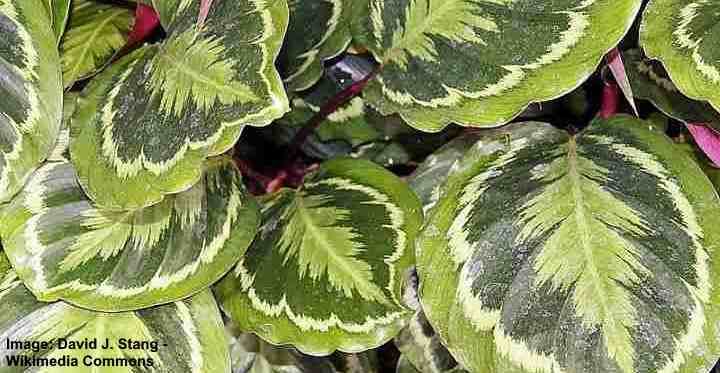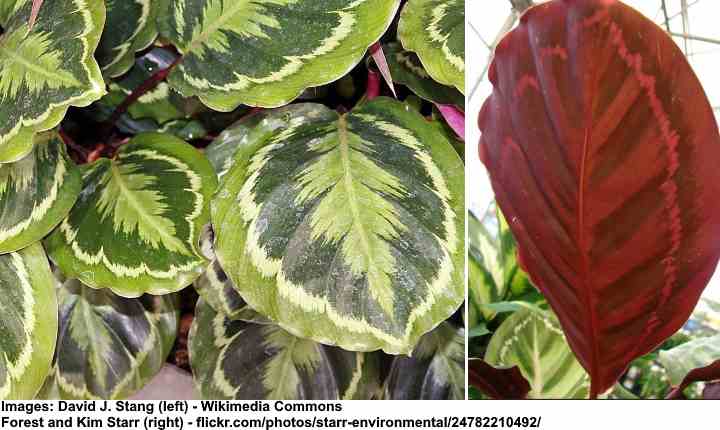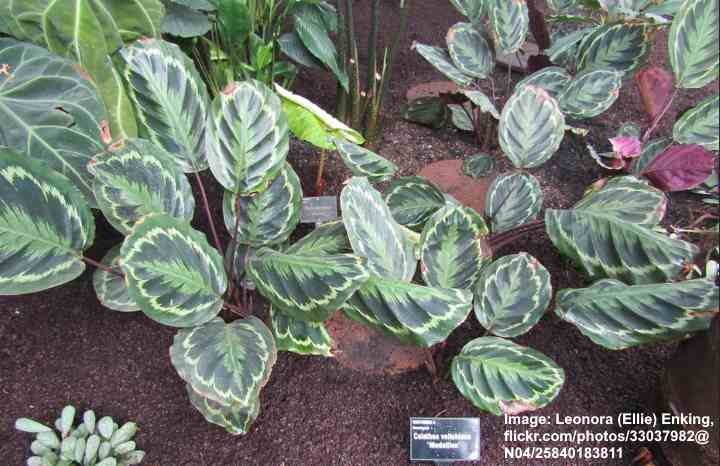Calathea Medallion: Care, Plant Profile and Growing Tips

Calathea Medallion is a popular houseplant that is easy to care for. The beauty of this type of calathea is its large oval green leaves with purple undersides. The colorful foliage of the Medallion calathea plant can help to brighten up any room, office, or other indoor location. Although calatheas are perennial tropical evergreen plants, they thrive indoors with minimal care.
How to care for calathea medallion: grow the calathea in well-draining potting soil and water the plant enough so that the soil is moist. The plant thrives in medium light, away from direct sunlight, high humidity at 50%, and average room temperatures of between 65°F and 80°F (18°C – 27°). Fertilize monthly during the growing season with a diluted liquid houseplant fertilizer.
What is Calathea ‘Medallion’?

Calathea roseopicta ‘medallion’ is a tropical plant in the family Marantaceae. This means that calatheas are related to prayer plants (Marantas).
Sometimes calatheas are called prayer plants because they raise their leaves at night like prayer plants. In the evening, the leaves of calathea plants fold upright at the base of the stem, as if the plant is folding its leaves upward to pray. This process is called nyctinasty.
There are many calathea species and hundreds of cultivars. Popular types of calathea include the pinstripe plant (Calathea ornata), rattlesnake plant (Calathea lancifolia), and zebra plant (Calathea zebrina).
Common calathea medallion care issues include curling leaves, brown leaves, or wilting leaves. At the end of the article, you will find out answers to questions related to caring for this tropical indoor plant.
Calathea Medallion Care

Calathea medallion plants are not fussy houseplants when it comes to caring for them. The three main requirements for the plant to thrive are:
- Adequate indirect sunlight
- Proper watering to keep the soil moist, but not soggy
- High humidity to mimic tropical climates
Let’s look in more detail at how to care properly for a calathea medallion.
Light Requirements for Calathea Medallion
Calathea medallion plants thrive in medium to low light, similar to their native habitat in tropical forests. You should keep the plant out of direct sunlight. Otherwise, it can suffer from leaf burn. Calatheas grow well in low light environments but grow better in medium to bright light.
The best location at home for a calathea is in a room that gets plenty of light. These variegated plants need enough sunlight to keep markings and patterns on their leaves vibrant. However, you can also place the tropical plant in a north-facing room or shaded corner where it will also grow well.
Bright, direct sunlight will scorch the leaves and cause the tips of the leaves to turn brown. If leaves start turning brown, move the plant pot away from direct sunlight. You will have to prune dead, brown leaves to improve the calathea appearance.
In addition to leaf burn, there are other reasons for brown leaves that you can read about at the end of the article.
How to Water a Calathea Medallion
Water a calathea medallion whenever the top 1” (2.5 cm) of the potting mix has dried. Thorough watering after the soil has partly dried nourishes roots without making the soil too soggy. When watering a calathea, ensure that water drains out the bottom. You should also avoid letting the plant stand in water.
A common mistake when it comes to watering houseplants—calatheas included—is to water on a schedule. Watering too frequently before the soil has partly dried leads to root rot, fungus gnats, and a host of other issues. Before watering, press the potting soil to test for moisture. If the soil is dry—thoroughly water your plant. If there is still moisture—hold off watering until the top 1” (2.5 cm) of potting soil is dry.
With calatheas such as the zebra plant, rattlesnake plant, and medallion plant, it’s best to under-water rather than over-water. So, err on the side of caution and avoid over-watering your tropical houseplants.
Here are some care tips for watering a calathea medallion:
- Provide deep watering to get moisture to the roots.
- Leave water out overnight so that harmful chemicals evaporate.
- Always use water at room temperature to avoid stressing roots.
- Don’t let plants sit in a saucer or tray of water.
- Water less frequently in winter.
- Always check that the soil is partly dry before watering.
The Best Soil for Calathea Medallion
Grow calathea medallion plants in a porous potting mix with good drainage. The worst thing for a calathea—and most houseplants—is to let them sit in waterlogged soil. The ideal potting soil for calathea plants should be a mixture of peat moss, perlite, and potting soil. This combination holds enough moisture but allows for adequate drainage.
Other ingredients to create a suitable potting medium are charcoal, coco coir, or orchid bark. If you want to buy a commercially available soil, a good quality African violet mix is ideal. The soil should be fertile, hold enough moisture, and drain well.
There are few other things to consider to help improve soil quality. Here are some care tips to help a calathea medallion thrive:
- Make sure that pots have drainage holes.
- Put a layer of pebbles along the bottom of the pot to improve drainage and airflow.
- The soil in terracotta pots dries out faster than soil in plastic or ceramic containers.
Temperature Requirements for Calathea Medallion
The ideal temperature range for calathea medallion plants is 65°F to 80°F (18° – 27°C). Average room temperatures are suitable for your houseplants to thrive. Keep the room temperature even. So, this means keeping plants away from hot sunlight, radiators, or air conditioning flow to avoid stressing the stunning houseplants.
Calathea medallion plants can be sensitive to temperature changes. If they get too hot, their leaves will start to curl. The plants don’t like cold drafts, and their leaves may start to wilt or droop.
The minimum temperature for calatheas is around 55°F (12°C). The plant can suffer permanent damage and die if left to grow in cold temperatures. So, if you grow calatheas in containers outdoors in the summer, bring them inside when the night temperature drops to 60°F (15°C).
Also, remember the light requirements when growing a calathea on a balcony, porch, or deck area. Place in bright light, but protected from direct sunlight. An east- or west-facing part of your yard is ideal. If in a south-facing location, make sure that the calathea only gets dappled or filtered sunlight between 11 a.m. and 3 p.m.
Calathea Roseopicta Medallion Care—Humidity
Keep humidity levels high when growing calathea plants indoors. To humidify the air around your plant, mist the leaves, use a room humidifier, or place on a pebble water tray. You can also group houseplants so that there is enough moisture in the air.
Household air tends to be too dry for moisture-loving tropical plants. Getting humidity levels right can be a challenge in winter due to heating. Also, in hot summers, room air can quickly become dry. However, adequate humidity levels will prevent medallion plant leaves from curling or drooping.
Here are the best care tips to ensure high humidity for your calathea medallion:
- Misting—Fill a spray bottle with distilled water. Spray the air around the plant with a fine mist. Try to avoid spraying directly onto the leaves.
- Humidifier—If you have many houseplants in one room, use a humidifier to get air moisture levels just right. This device should automatically keep humidity levels at around 50 percent.
- Humidifying tray—Put a layer of decorative stones on a deep tray. Fill the dish with water so that it’s half-way up the pebbles. Place your calathea pot on the tray, making sure the bottom of the pot doesn’t sit in water. Evaporation from the tray humidifies your plant naturally.
- Grouping plants—Plants create moisture when they “breathe.” So, grouping tropical houseplants can create the perfect humid environment for them to thrive.
Caring for Calathea Medallion—How to Fertilize the Plant
Feed your calathea medallion plant every four weeks during the growing season—from spring until the end of summer. Use a balanced houseplant fertilizer and dilute it to one-fourth strength. Avoid over-fertilizing your calathea plants, or they may become leggy, suffer from root burn, or die.
It’s important to remember that you don’t need to fertilize your houseplants during winter. Most tropical indoor plants go dormant during this period and don’t require any feeding.
An essential care tip to remember when growing calathea medallion at home is to flush the soil occasionally. Plants growing in pots tend to suffer from a buildup of mineral salts. Even if you feed your plant correctly, excess fertilizer can still build up. To keep your plant growing healthy, flush the soil this way:
- Take the plant pot to a sink or bath.
- Gently pour water through the potting soil for two to three minutes to flush out salts.
- Leave the plant to drain thoroughly.
- Put back in a location with medium to bright light.
After flushing the soil, wait until the potting mix partly dries before watering. Resume regular plant feeding after a few weeks.
Repotting Calathea Medallion
Calathea medallions rarely need repotting and should only be repotted a maximum of once a year. Sometimes, a calathea grows well in the same pot for two years or more. Repotting a calathea in spring allows you to refresh the potting mix, give roots more room to grow, and resolve any soil fungal problems.
The best time to repot calatheas such as pinstripe plants, rose-painted calatheas, zebra plants, and medallion plants is just before the growing season.
How to repot a calathea medallion:
- Gently remove the plant from the container.
- Shake excess dirt from the roots and run them under a faucet to remove all soil.
- Check the roots for signs of disease or decay and trim them as necessary.
- Choose a container that is 2” (5 cm) wider than the current pot.
- Fill the new container one-third full with fresh potting soil.
- Put in your plant and make sure it’s at the same height as in the previous pot.
- Fill the remaining space with a new porous potting mix.
- Thoroughly water and put in a bright location.
If you are repotting in the same pot, wash the container with soapy water and then trim the roots by one-third. Repotting this way prevents the calathea from growing larger and gives roots enough room.
Pruning Calathea Medallion
Being an easy-to-care-for houseplant, calathea medallion plants rarely require pruning. The large oval leaves grow on single stems, and there is little to prune. The only time you need to prune your plant is to remove brown or yellow leaves. All you have to do is cut the unsightly leaf stem where it joins with the main stem. Use scissors, a sharp knife, or pruning shears and sterilize them before using.
How to Propagate Calathea Medallion
Calathea medallion propagation is done by dividing the roots—called rhizomes—early in the growing season. Propagating medallion plants by seeds or cuttings is very difficult and often unsuccessful. However, only try to propagate a well-established, healthy calathea. Although they’re easy houseplants to look after, they don’t like being disturbed.
How to propagate a calathea medallion by rhizome division:
- Gently remove the mother plant and rhizome from the pot.
- Using a sharp, sterilized knife, cut the tuber so there is one or two stems and roots.
- Repot in a new container with the appropriate potting mix.
- Cover the new plant with plastic, keep it warm, and mist daily until new growth appears.
Are Calathea Medallion Houseplants Toxic?
No. Calathea medallion plants aren’t poisonous and won’t harm humans, dogs, cats, or other household pets.
Calathea Medallion Flowers
Calathea medallion is a flowering species of tropical plant that blooms in the wild. However, the plant never produces flowers indoors. But due to its stunning emerald green, silvery, and purple foliage, there is no need for blossoms to make this houseplant attractive.
Common Care Issues when Growing Calathea Medallion
In this section, we look at how to resolve common problems plant owners face when growing medallion plants.
How to get rid of pests infesting calathea medallions
Damp soil can attract fungus gnats, and the large leaves attract thrips, aphids, and other pests. To get rid of these pests, only water the plant when the top part of the soil has dried. If you notice signs of houseplant pests such as aphids, thrips, mealybugs, or spider mites – read our article on how to get rid of bugs on houseplants.
Common calathea medallion diseases
Most fungal problems that afflict calatheas are due to moisture and watering issues. If you notice signs of white mold on plant soil, scrape it off. Hold off watering your plant until the top 1” to 2” (2.5 – 5 cm) of the potting mix dries. Only water when the soil has partially dried to prevent fungal issues.
Why are calathea medallion leaves yellow?
Over-watering is the most common reason for calathea medallion leaves turning yellow. So, if the soil is overly damp, don’t water the plant until it mostly dries out. However, yellowing leaves can also be a sign of under-watering, pest infestation, or standing in a cold draft.
Why are calathea medallion leaves turning brown?
One reason for calathea leaves turning brow is a thrip infestation. Look for tiny black insects that craw on the underside of leaves or stems. Treat with neem oil to get rid of them.
Why does calathea leaves have brown edges?
Brown crispy edges on the large calathea leaves are due to moisture issues. For example, the leaf edges will turn brown if the soil is completely dry. Also, poor humidity, cold air, or misting with unfiltered tap water can cause unsightly brown margins on calathea leaves.
Why do calathea medallion leaves curl up?
Curling leaves on a calathea are a sign that your plant is thirsty. Not watering enough or poor humidity can cause leaves to roll up into a tub-like shape. Give your plant a thorough watering and mist the leaves with distilled water or filtered tap water to revive a wilting plant.
My calathea leaves are dying—what should I do?
Signs that a calathea is dying are drooping leaves, yellowing or browning leaves, poor growth, or curling leaves. The only way to revive a dying calathea is to eliminate the root cause. So, check for signs of pests, stick to a proper watering schedule, and mist regularly to increase humidity. You may need to repot a calathea to freshen up the potting mix and get rid of wet, soggy soil. Also, low light can cause your calathea to look poorly.
Why do calathea leaves have brown spots?
Brown spots on calathea medallion leaves could be a sign of a pest infestation or overly dry air. Make sure that there is enough humidity in the room as well as adequate airflow. If there are pests or bugs on your plant, use natural ways to kill bugs on houseplants such as neem oil spray to kill off indoor plant pests.
Related articles:
